Sympathy for Lady Vengeance marks the conclusion of Park Chan-uk's “Trilogy of Vengeance”, following Oldboy (2003) and Sympathy for Mr. Vengeance (2002) (1). Under the same basic idea, Park created a set of three appealing thrillers, with a sparkling aesthetic component and a remarkable balance between visual design and the use of sound and music, suggesting the director's perfect control over every extension of the art process applied to each component of its work.
If Mr. Vengeance connects three characters whose actions and decisions seem controlled by a superior being, a will whose plan they carry out without fully understanding it, Oldboy materializes this will in the body of a yuppie and wealthy businessman whose sole reason to live seems to be the fulfillment of a meticulous plan in which Dae-su (Choi Min-sik) constitutes its raw material.
The complex web of misfortunes in the first film and the sadistic refinements the vengeance's mentor puts into the carrying out of his goals in Oldboy generate violence at the edge of what one may bear — the characters, blind by their desire of retribution, carry out actions of the utmost cruelty.
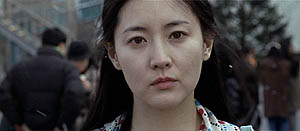 |
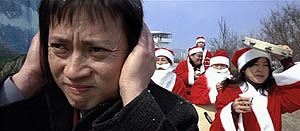 |
As she leaves prison, Lee Geum-ja (Lee Yeong-ae) is welcomed by a coffee-drinking Santa Claus chorus line. |
With Lady Vengeance, the protagonist appears to be in complete control of the situation. Retribution may only end up in violence and bloodshed but in the executioner's mind there is not blind punishment as much as there is the pursuit of justice together with a need for redemption due to the long trail of sins committed along the way.
There are narrative elements and concepts that we can find on the three films. One of the themes present in the whole trilogy is the violent rupture of family ties: children taken from their parents by force. There is always a kidnapping, whether it is the children's or the parent's (as in Oldboy), and one single parent, and we may also find similar precautions passing through the kidnappers' minds in Mr. Vengeance and Lady Vengeance.
Park insisted on inviting the protagonists of his previous films to do cameos: Song Kang-ho and Shin Ha-gyun (Sympathy for Mr. Vengeance, but also J.S.A.), Kang Hye-jeong and Yu Ji-tae (Oldboy). The supporting cast also includes some familiar faces from his previous films, such as Oh Dal-su (the bakery's owner), Kim Byeong-ok (the preacher) and Lee Seung-sin (Park Hi-jeong, an ex-convict).
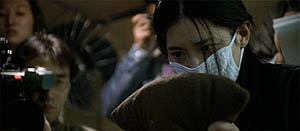 |
 |
Crime reenactment before the press. In prison, Geum-ja summons the angel she found within herself. |
The complexity of Geum-ja's character makes it difficult to determine where the influence of religion in her psyche ends and where does her control over that and other surrounding elements begin. What appears to be clear is the fact, considering the way she salutes her pastor, that the day she gets out of prison religion is the last of her concerns.
It might be safe to say that her goal turns into her religion. Both Christianity and Buddhism are reduced into functional and practical purposes. We will see her lighting candles near a rather peculiar altar consisting of two police posters: one announcing the child's disappearance and the other with the suspect's sketch. Her prayers and her dreams do not include Jesus or Buddha but a man being (literally) shot as dog.
Park Chan-uk's mastering of the language of cinema reaches in Sympathy for Lady Vengeance a remarkable level; the exquisite production design and the attentive composition are at the service of both the themes and the symbolism that traverses the whole film, based mainly on the use of the black, the white and the red, which begins immediately with the initial credits. White stands for purity and redemption; red meaning sin, crime and violence (but also seduction).
 |
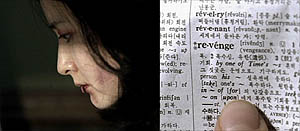 |
A prayer for a vengeance. |
The function of colour might seem too obvious but its use in the context of the impressive visuals flows very naturally. This representation appears in the costumes and the make-up, in the food (tofu and sweets) or even through atmospheric elements such as the snow. The corruption of purity is displayed by blood on the snow, but even a strawberry pie reveals how Park cares for detail. Also, immediately at the beginning of the film, Geum-ja is welcomed, when leaving prison, by a chorus of Santa Claus wearing the trademark red and white garments.
Park masterfully applies several mechanisms to break the film's chronological continuity, building a strong and dynamic introduction sequence where we may see a set of events we will only fully understand throughout the next minutes. The power of the image (worn-out and manipulated), the camera — one might think it to be possessed — and the use of music seduce and catch our attention for the next two hours. Closer to the end, there is another moment where the flash-forwards are used very skillfully, strengthening the drama and confusion in the characters' minds.
 |
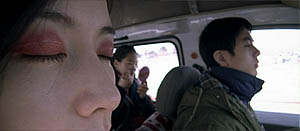 |
Trees as symbols. On the way to school. |
The agent of vengeance in the third film is no longer dominated by despair or by the emergency of committing the act. She takes her time to think over it. Motivation is no longer sheer irrational vengeance but the weight of guilt that eventually will grow exponentially — as if stating that the characters are not merely at the service of the script; there are some mishaps and the need to adjust to new realities.
There is also a kind of twisted and violent altruism from someone who regrets her sins and the fact she used others to achieve her goals. One of the greatest contrasts in the film is the fact that abnegation is “shocking” rather than “touching” — or, from another point of view, if it is touching it is because of the shock.
Park Chan-uk still keeps his sense of humour along the narrative, such as the reference in TV to the opportunist who is adapting Geum-ja's story to the cinema or an English-Korean dictionary where the first word one to appear is “ellipsis”.
The Sympathy for Lady Vengeance DVD allows us to watch an alternate version of the film where, from a certain point in the narrative, colour begins to fade until it turns into black-and-white. The difference between the two versions is merely this colour variation, consisting of a rather modest “effect” when compared to the visual sophistication that traverses the entire film. The option strengthens the use of colour as a symbolic element but I must confess that while watching the film again in its cinema version I did not miss the black-and-white.


